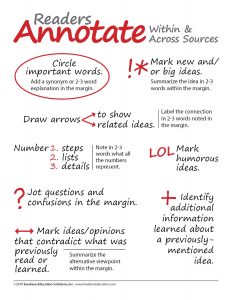
MLC: A Beginner’s Guide to Annotating
MLC: A Beginner’s Guide to Annotating
The most formative years of your child’s educational experience happen in elementary and middle school. These are the years your child is building study habits and skills, confidence both in and outside the classroom, and creating the foundation for lifelong learning that will extend into high school, college, and beyond.
Unfortunately, districts push classroom teachers to focus on mastery of Common Core State Standard objectives and to make up for Covid-19 pandemic learning loss over teaching essential study skills. Oftentimes, students end up having to teach themselves study skills, which leads them to pick up bad habits that get reinforced the more they practice them.
That’s why MEK wants to set your child up for success by giving them the tools to excel in their studies. You can even read our blog, where we give your child our expert tips for how they can get the most out of their current classes.
In that blog, we talked about the importance of setting aside time every day to review notes, practice skills learned in class, and read. But we also talked about an essential study skill: annotating texts.
Read on to learn about the importance of annotation skills and our guide to annotating texts!
What does it mean to annotate a text?
Annotating a text is, essentially, marking specific words and passages in a piece of writing that are important to you for a variety of reasons. It is the way in which you “talk to the text.”
Why is annotating a text important?
Annotating a text is part of being an active reader. When you are engaging with a text through annotating, you are building and improving your reading comprehension and analysis skills. This is because you are putting difficult concepts into your own words, asking questions about challenging passages, and making connections between your experiences and the text. You’re also better able to distinguish between essential and nonessential information.
How do you annotate a text?
It may sound silly, but the first step to annotating is deciding what method you will use. Do you like to underline with a colorful pen or pencil? Do you want to use highlighters to make note of passages? Or do you want to create a key with symbols that mean different things (for example: put a star next to interesting sentences, circle new or difficult vocabulary, write a question mark next to passages that you have questions about). Below is an example of an annotation key.
 How you want to annotate is personal to YOU. So, you get to decide what your annotations look like. But some helpful tools for the annotating process are:
How you want to annotate is personal to YOU. So, you get to decide what your annotations look like. But some helpful tools for the annotating process are:
- Colored pens and pencils
- Markers/highlighters
- Post-its or tabs for marking pages
What should you look out for when annotating?
Annotating is actually a pretty simple skill. But, if you’re just starting out, it can feel overwhelming. Here’s a guide to what you should look out for!
1. INFORMATION THAT’S IMPORTANT TO THE OUTCOME OF THE TEXT
I know you might be wondering: but what does “important information” mean? Important information refers to information that is essential to the outcome of the story, word problem, science passage, or non-fiction text.
For example, if you’re reading a chapter book or novel, you want to make note of character names and descriptions, big events, conflicts, and how the conflict is resolved.
2. NEW OR DIFFICULT VOCABULARY
When reading a book, a poem, or even a word problem, pay close attention to any vocabulary words you’ve never seen before. Then, underline, circle, or highlight the word and look up for the definition. You can write the definition in the margin of the text next to the word or create a specific section in your notes for new vocabulary.
3. SECTIONS OF THE TEXT THAT YOU HAVE A QUESTION ABOUT
While you are reading, you want to make note of any time a section of text makes you go, “Hm. I wonder what that means?” Then, you want to either write your question in the margin next to the quote or on a post-it that you affix to the page on which you have a question.
It’s important that you keep track of any questions that you have about the text so that you can ask your teacher. And these questions can even help you come up with ideas for essay topics later on!
4. QUOTES THAT ARE MEANINGFUL TO YOU
Whenever you are reading and the story makes you feel happy, sad, angry, or any other emotion, underline or highlight the quote. Then, make a brief note about what the quote made you feel and why.
By identifying meaningful quotes, you’re exercising your analysis skills and drawing connections between your personal experiences and the text.
Next Steps
Annotating is just one of many study skills your child can use to improve their reading comprehension, build their vocabulary, and practice analysis skills.
If you’re looking to help your child build strong study habits, check out our MEK Learning Circles!
Our MLC program is designed to meet your child at their current academic level in order to guide them toward mastery of key concepts in their current classes.
The first step is to take either our free, virtual MEK Learning Circles Evaluation Test. You’ll receive our detailed score report, a free consultation with the Director of MLC, Ms. Binal Patel, and a personalized plan to help your child meet their goals.
Contact us today to get started!



